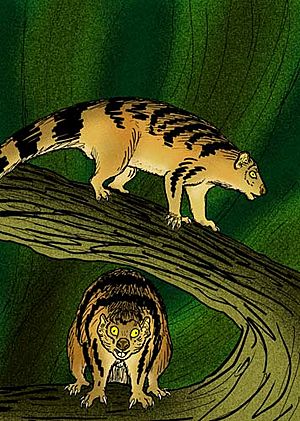Microleo facts for kids
Microleo attenboroughi is a very tiny ancient animal that lived in Australia about 18 million years ago. It was a type of meat-eating marsupial, part of a family called Thylacoleonidae, which are also known as marsupial lions. Even though it was small, it was a fierce hunter!
This little creature lived in a wet forest that covered the area now known as Riversleigh in Queensland. Scientists found parts of its skull and jaw with teeth. These fossils helped them understand that Microleo was a new kind of marsupial lion. It was named after the famous naturalist David Attenborough, who helped bring attention to the important fossil site where it was found.
Quick facts for kids Microleo |
|
|---|---|
 |
|
| Scientific classification |
Contents
What Kind of Animal Was It?
Scientists officially described Microleo attenboroughi as a new species and genus in 2016. It's the only known species in its group, Microleo. It belongs to the family of Thylacoleonidae, the marsupial lions. These were powerful meat-eating marsupials that lived in Australia for millions of years, from the Miocene to the Pleistocene epochs.
Microleo is thought to be one of the earliest members of the marsupial lion family. Even though its relatives were much bigger, scientists called Microleo the "feisty kitten" of the family because of its small size.
Why the Name Microleo attenboroughi?
The name attenboroughi honors David Attenborough. He is a well-known TV presenter who loves nature. He helped make the Riversleigh World Heritage Area famous, calling it one of the four most important fossil sites.
The name Microleo comes from two words:
- Micro is an Ancient Greek word meaning "small."
- Leo is a Latin word meaning "lion."
So, Microleo means "small lion," which perfectly describes this tiny marsupial predator!
What Did It Look Like?
Microleo attenboroughi was a very small animal, especially compared to other marsupial lions. Its relatives could weigh from 2 to 130 kilograms (about 4 to 286 pounds). But Microleo was only about the size of a modern ring-tailed possum. It weighed around 600 grams (about 1.3 pounds).
This little hunter lived about 18 million years ago in a very wet, forested area. It was a carnivore, meaning it ate other animals. It probably hunted the many different creatures living in its forest home.
Its Special Teeth
Scientists found parts of its upper jaw (palate) and lower jaw. These fossils showed its unique teeth. Like other marsupial lions, Microleo had special knife-edged teeth called premolars and molars. These teeth were perfect for killing and eating other animals. The shape of one of its premolar teeth (called P3) was so unique that it helped scientists realize it was a completely new type of animal.
Where Did It Live?
Fossils of Microleo attenboroughi were found at a place called "Neville's Garden Site" within the Riversleigh area. This site is famous for having many different kinds of fossils. Scientists have figured out that the fossils here are about 18 million years old.
Today, Riversleigh is a dry, open woodland. But when Microleo lived there, it was a lush rainforest with lots of rain and a mild climate. It was probably similar to the rainforests you find in places like Borneo today.
Its Forest Home
Microleo likely lived in the trees, making it an arboreal animal. This helped it stay safe from bigger predators. Other, larger marsupial lions, like Wakaleo species, also lived in the same area. They might have competed for food. But Microleo's small size probably allowed it to climb higher into the forest canopy. This way, it could hunt insects, birds, and lizards that lived in the treetops, while staying out of reach of bigger animals.
See also
 In Spanish: Microleo para niños
In Spanish: Microleo para niños

